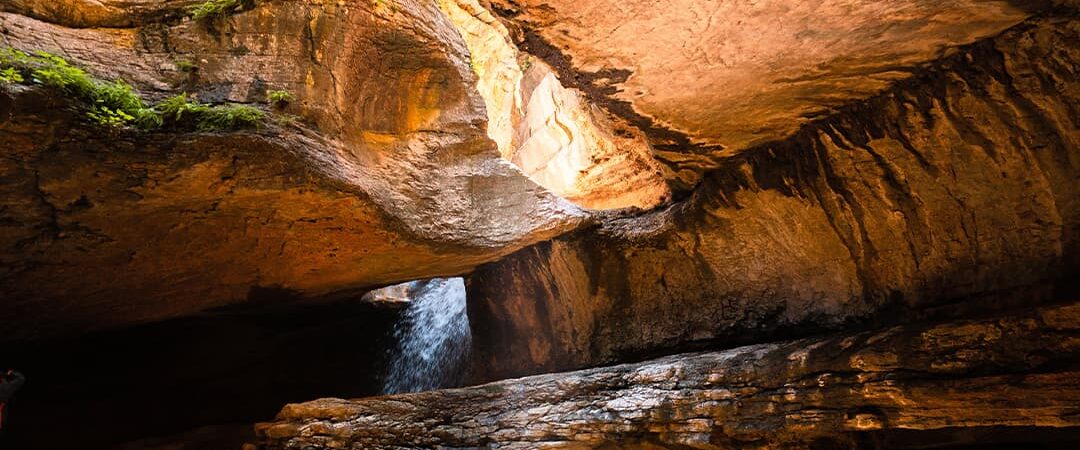Waitomo are famous karst caves that are the main attraction in the south of the Waikato Region, on the North Island of New Zealand. They have gained their fame for their luminous ceilings, which are very reminiscent of a starry sky.
The Waitomo community itself is small, although the village does attract many temporary workers who live there as well. The word “Waitomo” is formed by the Maori words “wai” – water and “tomo” – funnel; thus, the whole word can be translated as “water passing through an opening”.
It is truly a masterpiece of nature, which it has labored over for many millions of years. For centuries, the ocean ruled here, creating bizarre outgrowths of limestone and mysterious intricacies of passages. Then the water receded, creating a system of about 150 caves. The most famous of these is Glowworm Cave. It is inhabited by amazing creatures called Arachnocampa Luminosa. These are fireflies, which can be found only in New Zealand. Their green-blue glow makes the vault of the cave look like a starry sky on a frosty night. It’s really better to see it once… And also to feel and hear it: it smells extremely pleasant here, and in the Cathedral Hall of the cave on Christmas night they sing a cappella. Fans of extreme sports are advised to take part in rafting on the “black” water.
So, tourists come to Waitomo caves to see… the starry sky. This is how the ceilings of the cave look with the larvae of fireflies Arachnocampa luminosa, which, according to scientists, glow mainly from hunger. And the more acute hunger – the brighter the glow.
Thus, the researchers say, the larvae lure insects into their traps – threads of silk, which this little thing spins, hangs from the ceiling and makes them hang. In fact, other researchers have found that the amazing fireflies may well do without insects, and happily feed on fungal spores, which do not need to be lured anywhere. In addition, thousands of glowing from hunger larval ventricles are able to “turn off”, afraid of the approach of curious tourists. So the marvelous illumination in the cave darkness is simply the tiny creatures’ quest for beauty and perfection. These Caves are believed by some scientists to be more than two million years old.
The limestone formations surrounding the Caves Region have been the center of increasingly popular tourism and speleology since as early as 1900. Initially, the Caves were initially visited mainly by impromptu excursions conducted by the local Māori population. The Waitomo Caves were then placed under government supervision and since 1904 have become a permanent pilgrimage site for tourists, with numbers increasing year on year. Today there are many tour companies, large and small, specializing in guided tours throughout the Caves, from easily accessible areas with hundreds of tourists per hour during the peak winter season, to extreme speleological sporting events in difficult to access cave systems that can only be seen by a few tourists per day.
A visit to Waitomo Caves was ranked 14th in the Automobile Association’s 2007 “101 Kiwi must-do’s” survey of the most popular tourist destinations among over 20,000 New Zealand motorists, and in 2004 the peak tourist visitation to the Caves was recorded at approximately 400,000 visitors.
Waitomo Cave Complex is: Waitomo Cave, Ruakuri Cave, Aranui Cave and Gardner’s Gut. They are world famous for their stunning stalactites and stalagmites, as well as for the presence of a large colony of fireflies (Arachnocampa luminosa). In the total darkness of the Caves, the fireflies shine brightly like stars on a cloudless night.
Waitomo is easier to reach by car from the town of Te Kuiti (only a few minutes), but hiking there is also popular. The caves are open daily without weekends and holidays: 9.00 am – 5.30 pm.
The caves were first explored in 1887 by local chief Tane Tioranu and English naturalist Fred Mays. At the time, local Māori people were aware of the existence of the caves, but the underground caverns had not been explored. Tane Tioranu and Fred Mays built a raft from flax stalks, took a light and swam to the caves. Once inside the caves, they were blinded by the light from the many bright lights. Once their eyes got used to the darkness they saw many lights reflecting off the water, looking up they found the ceilings dotted with many insects. Once back they continued to further explore the caves and the insects found in the caves.
